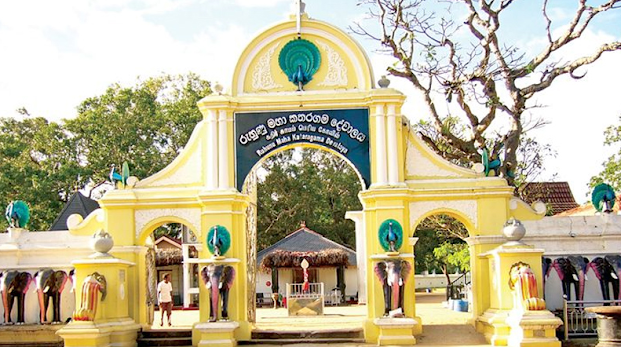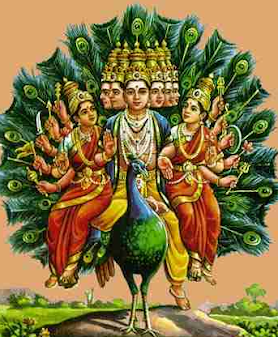Kataragama
Kataragama
Kataragama is a holy pilgrimage town to Hindus, Buddhists
and Veddas of Sri Lanka. People from South India also come to worship. The
Kataragama temple, a temple dedicated to Skanda Kumara, also known as
Kataragama deviyo, is located in the town.Kataragama is located in Monaragala
District of Uva Province, Sri Lanka. It is 228 kilometers (142 mi) southeast of
Colombo. Although Kataragama was a small village in ancient times, today it is
a fast-growing city surrounded by forest in the southeast of Sri Lanka.
The ancient Kiri Vehera Buddhist stupa, which is believed to
have been built by the regional king Mahasena in the 6th century BC is also a
major attraction in the Kataragama area. The town has a venerable history
dating back to the last century BC. It was the seat of power of many Sinhalese
kings during the Rohana dynasty.Since the 1950s the city has undergone many
improvements with successive governments investing in public transport,
hospitals, and business development and hotel services. It is adjacent to the
famous Yala National Park.
Early history
The vast area of Kataragama has yielded evidence of human
habitation at least 125,000 years ago. It has also yielded evidence of
Mesolithic and Neolithic settlements.
Historic period
During the historic period, the public area was
characterized by small reservoirs for water conservation and peat farming. The
village of Kataragama is first mentioned in the historical record called
Mahavamsa written in the 5th century AD. It mentions a town called Kajjaragama
where the important honor came to find the sacred Bo sapling sent by Ashoka's
Mauryan Empire in 288 BC.
It was the capital of the number of kings of the kingdom of
Ruhuna. It gave refuge to many kings from the north when the north was attacked
by the kingdoms of South India. It is believed that the site was abandoned
around the 13th century.
Based on the findings of the remains, it is believed that the Kiri Vehera was renovated or built in the first century AD. There are many other inscriptions and ruins. By the 16th century the Kataragamadevio church in Kataragama had become synonymous with Skanda-Kumara who was the patron deity of Sinhala Buddhism. The city was known as a place of pilgrimage for Hindus from India and Sri Lanka in the 15th century. The popularity of the god in the temple of Kataragama was recorded by Pali legends of Thailand such as Jinkalmali in the 16th century. There are Buddhist and Hindu legends related to the special things in the place. Scholars such as Paul Younger and Heinz Bechert speculate that the rituals performed by the actual priests of the Kataragama temple betray the Vedda concept of redemption. This is why they believe that the area of Vedda veneration was taken by the Buddhists and Hindus in the ancient period.
Temple of Syncretism
Kataragama is a holy town with many religions. Despite
ethnic and religious differences, many Sri Lankans show great respect for God
Kataragama. They respect him as a very powerful god and ask for divine help to
solve their personal problems or success in business, etc., with the strong
hope that their requests will be accepted. They believe that God Kataragama
exists and has been given extraordinary power to help them pray to him with
faith and devotion in times of trouble or calamity.
Hindu katharagama
Tamil Hindus of Sri Lanka and South India call the place
Katirkamam. Katirkaman is associated with Skanda-Murukan. Saivite Hindus of
South India call him Subrahmanya. He is also referred to by the names
Tarakajith, Katiradeva, Katiravel, Kandasamy, and Kartikeya. The root katir
from Katirkamam is the source of some of these names. "Katir" means
formless light. God is shown with six faces and twelve arms or one face with
four arms. Out of love for Murugan and to reduce bad karma, bhaktars pierce
their cheeks and tongues with veils, pull large chariots carrying Murugan's
murthi and large hooks are pierced into the skin of their backs. This practice
is known as kavadi. Murugan's vehicle is Mayil, the peacock.
There is a special community called Sella Katirkamam dedicated to the beloved elephant-faced God Ganesha nearby, who is known as the elder brother of Murugan. The Manik Ganga or Manika Gangai (River of Gems) is a bathing place where you can take a holy bath to purify yourself. Local people have reported that one can be cured of illness by bathing in the precious gemstone and medicinal properties of the roots of the plants. line to the river in the forest.
Buddhist Kataragama
Many Sinhala Buddhists of Sri Lanka believe that Kataragama
deviyo is a guardian deity of Buddhism and she is the presiding deity of the
Kataragama temple. Kataragama is one of the 16 Buddhist centers to visit in Sri
Lanka. According to the history of Sri Lanka, the Mahawamsa, when the Bo
sapling of the Bodhi Tree, where Gotama Buddha received enlightenment was
brought to North India in the city of Anuradhapura 2,300 years ago, the
warriors or Kshatriyas from Kataragama were on hand to pay homage and respect.
The Bo tree behind the Kataragama temple is one of the eight
saplings (Ashta Phala Ruhu Bodhi) of Sri Maha Bodhiya in Anuradapura, Sri
Lanka. The third century BC saw the planting of this tree.
The Buddhist Kiri Vehera Dagoba which is located near the
Kataragama devalaya was built by King Mahasena. According to legend, Buddha, on
his third and final visit to Sri Lanka, is believed to have met King Mahasena,
who ruled the Kataragama area in 580 BC. It is said that King Mahasena met
Buddha and heard his discourse. As a sign of gratitude, the Dagoba was built in
the exact place where it stands today. Therefore the Sinhalese Buddhists in the
locality of Kataragama believe that it was consecrated by Buddha.
Kataragama deviyo
Kataragama deviyo is a guardian deity of Sri Lanka. A famous
deity who is considered to be very powerful, special objects dedicated to
Kataragama deviyo are found in many places of the country. Sinhalese Buddhists
also believe that he is a divine patron of the Buddha Sasana in Sri Lanka. An
ancient temple dedicated to God Kataragama, known as Ruhunu Maha Kataragama
Devalaya is located in the South-eastern town of Kataragama in Monaragala
District of Uva District.
Today Ruhunu Maha Kataragama devalaya has become a temple
that attracts and unites people of different religions and faiths. Thousands of
devotees from Sri Lanka and other parts of the world visit this temple every
day. Katagama deviyo is identified with God Skanda of Hindu tradition, called
Murugan by Tamil people. Mahayana Buddhism also has a similar guardian deity,
called Skanda. Theosophists identify Ruhunu Kataragama devalaya as a temple
dedicated to Sanat Kumara, the lord of mankind and the world.
Katharagama devalaya
According to legend, the Ruhunu Maha Kataragama Devalaya was
built by king Dutugemunu around 160 B.C. as a fulfillment of a promise made
before his successful military campaign against the Chola invasion king Elara
occupied the capital of Sri Lanka in Anuradhapura. It is said that King
Dutugemunu received the blessings and guidance of God Kataragama to make his
journey against. the king of Elara. King Dutugemunu constructed the temple and
dedicated it to God Kataragama following his victory. He also appointed
officials to look after the devalaya.
The construction of the Kataragama temple is a simple structure with two apartments and no major structural changes were made after its construction. and decorating pictures of peacocks and elephants. Next to the main temple there are temples dedicated to Lord Vishnu and Lord Ganesha. Another temple located directly in the Kataragama devalaya is dedicated to the goddess Thevani, a consort of God Kataragama.
Pre-Hindu and Buddhist origins
The god in Kataragama is a native and has long been
celebrated in Sri Lankan lore and legend, and he once lived on the mountain
peak called Wædahiti Kanda (or the mountain of the Vedda people) outside the
town of Kataragama. Since ancient times there is an inseparable connection
between God Kataragama and his group. At one point the village god was
identified with God Saman, a Buddhist and Sri Lankan guardian deity.
As in the Sinhalese culture, local ancestors, rulers and
kings, who did a great service to the country or community were ordained as
gods. According to legend, God Saman was an ancient ruler of the Deva people in
the Sabaragamuwa area of Sri Lanka. Therefore, some believe that King
Mahasena, who built the Kiri Vehera in Kataragama later became the Kataragama
God.
The god in Kataragama is a native and has long been
celebrated in Sri Lankan lore and legend, and he once lived on the mountain
peak called Wædahiti Kanda (or the mountain of the Vedda people) outside the
town of Kataragama. Since ancient times there is an inseparable connection
between God Kataragama and his group. At one point the village god was
identified with God Saman, a Buddhist and Sri Lankan guardian deity.
As in the Sinhalese culture, local ancestors, rulers and
kings, who did a great service to the country or community were ordained as
gods. According to legend, God Saman was an ancient ruler of the Deva people in
the Sabaragamuwa area of Sri Lanka. Therefore, some believe that King
Mahasena, who built the Kiri Vehera in Kataragama later became the Kataragama
God.
The god in Kataragama is a native and has long been
celebrated in Sri Lankan lore and legend, and he once lived on the mountain
peak called Wædahiti Kanda (or the mountain of the Vedda people) outside the
town of Kataragama. Since ancient times there is an inseparable connection
between God Kataragama and his group. At one point the village god was
identified with God Saman, a Buddhist and Sri Lankan guardian deity.
As in the Sinhalese culture, local ancestors, rulers and
kings, who did a great service to the country or community were ordained as
gods. According to legend, God Saman was an ancient ruler of the Deva people in
the Sabaragamuwa area of Sri Lanka. Therefore, some believe that King
Mahasena, who built the Kiri Vehera in Kataragama later became the Kataragama
God.
Even today the Vedda people come to pay homage to the temple
from their groves. As a link to the Vedda past, the temple holds its annual
festival to celebrate the God's friendship and marriage to a Vedda princess in
July to August.
Most of the thousands of visitors to Kataragama travel by
car. Even today, despite the appeal of modern transportation, hundreds of
dedicated pilgrims stick to the ancient tradition of traveling to Kataragama on
foot.
In 1992, it was planned to extend the railway from Matara to
Kataragama and beyond. The Kataragama railway extension is being built under a
three-phase accelerated development programme. The first phase has started and
will cover 27 kilometers from Matara to Beliatta costing 60 million rupees; the
construction of the bridge over the Nilwala River has already been started by
the State Engineering Corporation. The entire project will take six years to
complete and will cost approximately 3 billion dollars. The project is funded
by the Chinese government and is expected to be completed in 2015.








Comments
Post a Comment